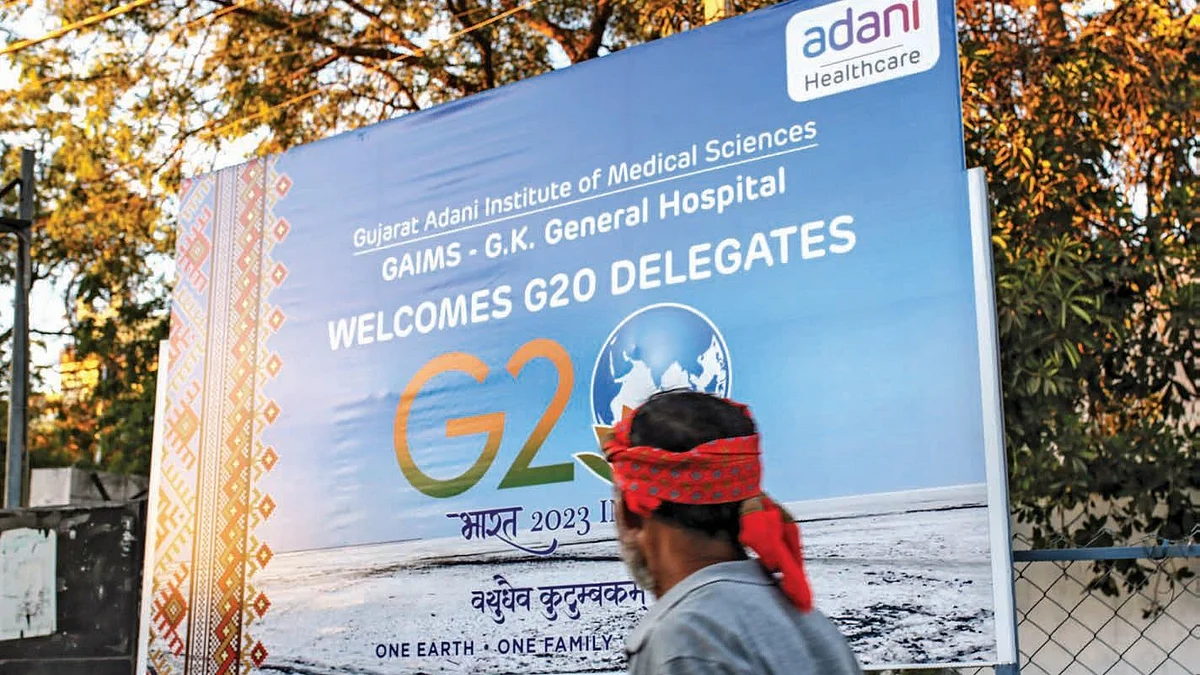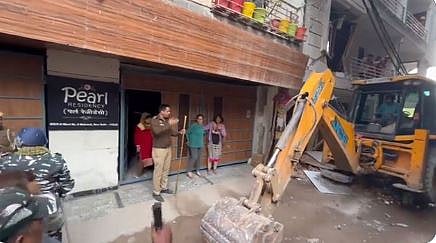We20 versus G20: India’s war on its poor
To preen for the G20 spectacle, the government has run a determined ‘gareebi chhupao’ campaign

How big a deal is the G20 summit in New Delhi? A very big deal, according to minister of external affairs S. Jaishankar and others in the government. Never have so many world leaders, they emphasise, visited India at the same time. It shows India has emerged as the voice of the global south, they crow.
It is necessary, however, to temper the exuberance. Take an objective look at the statements being made.
Claim: Never in the past 10,000 years has India had the honour of hosting a G20 summit. Fact: Correct. The G20 was formed in 1999 and includes 19 countries and the EU.
Claim: Now, thanks to Amrit Kaal, leaders of every country unanimously selected India to host the G20 Summit because we are simply the best and most prestigious country in the world. Fact: False. G20 members hold the presidency and host the summit by rotation.
The last four summits were held in Indonesia, Italy and Saudi Arabia (a virtual summit). As for being the ‘best’ country… Other members know where we stand, let’s leave it at that!
Claim: By hosting the G20, the government will solve India’s age-old problems of poverty, unemployment, communal hatred, environmental degradation, rising inequality— all in one go. Fact: Yes/No. Those who do not want the Intelligence Bureau or income tax sleuths to come snooping will say ‘yes’. Others can anonymously say ‘no’.
Come 9–10 September, New Delhi will host the leaders of the 19 other G20 member countries, nine invitee nations and various international organisations. As the Indian government pulls out all the stops, orders have gone out to shut down offices, educational institutions, banks and markets in the New Delhi police district, including Connaught Place and Khan Market.
Slums have been demolished, street vendors have been asked to relocate and most of them, alongside established shopkeepers, will lose business and their earnings during the summit.
A spectacular opening ceremony, banquets, heritage walks, cultural evenings and photo ops are being planned. Lakhs of potted plants, flower beds and ‘flower fountains’ are being set up to greet the leaders.
In February this year, the New Delhi Municipal Corporation imported 1.24 lakh tulips from the Netherlands to decorate Delhi for one of the working group or ministerial meetings of the G20.
How many more flowers are being imported for the main summit will doubtless come to light in the course of time. A hundred such meetings at as many venues have reportedly been held since December 2022, when India took over the rotating presidency of G20.
The cost is best left to the reader’s imagination. What the total expenditure from the Indian exchequer will eventually add up to for the summit is anybody’s guess. What is known, however, is that the Union government’s budget for the year 2023–24 had set aside Rs 990 crore for India’s G20 presidency.

“In these times of global challenges, the G20 presidency gives us a unique opportunity to strengthen India’s role in the world economic order,” the finance minister had stated in her budget speech. The prime minister, meanwhile, had addressed an all-party meeting last year to seek everyone’s cooperation to make the G20 summit a success. (Remarkably, he is yet to address an all-party meeting on the Manipur crisis.)
At the meeting, the prime minister reminded everyone that the summit involved “national pride” and would offer opportunities to showcase every state. The states were nudged to put their best foot forward and showcase their crafts, cuisine and “tourist spots”.
The summit would offer an opportunity to “network”, share and exchange ideas and explore business opportunities and avenues of cooperation, it was pointed out. Opposition leaders speaking at the meeting had urged the prime minister to refrain from claiming the G20 summit as the government’s ‘achievement’, pointing out that it was rotational.
They did, however, agree to cooperate. The states of course had little option but to fall in line. Now violence-torn Manipur had hosted one of the first meetings in February this year and unveiled a ‘water amusement park’ at Imphal, undoubtedly to amuse the delegates.
The meeting, hoped chief minister N. Biren Singh, would give the state’s economy a boost. The state, already simmering, has since descended into a spiral of ethnic clashes it is yet to recover from almost four months later. In Jammu & Kashmir, Srinagar Smart City Ltd. (SSCL) was tasked to “facelift and renovate” the permanent bunkers on the main roads, including the route from Srinagar airport to the Sher-e-Kashmir International Convention Centre (SKICC) on the Dal Lake, the main venue of the G20 meet in May.
Around 200 delegates, less than half of them from G20 countries, attended. Srinagar residents were asked to pitch in and improve the facades of their homes by painting them white or peach for a suitably picturesque backdrop, which was clearly lacking in a state of doubtful natural beauty.
There were muted protests in some cities. In Visakhapatnam, the Jana Sena Party alleged that public money had been misused in the name of development works ahead of the G20 working group committee meeting.
The work of ‘facelifting’, it alleged, was confined to NH-16, the Beach Road and a few other areas likely to be visited by the delegates. Tender norms were violated and emergency purchases were made, it said.
“For painting eight animals on rocks, the Greater Visakhapatnam Municipal Corporation has claimed to have spent Rs 12 lakh. Who on earth pays this amount for painting animals on rocks?” an irate spokesperson asked. G20 is, however, a ‘big deal’ for the government.
Addressing the Indian diaspora in Austria earlier this year, Jaishankar said, “I sometimes get the question—you can imagine from which quarters—saying, well, it (the G20 summit) was bound to come your way anyway. So what’s the big deal? It is a very big deal. Because in our diplomatic history, we have never had this many powerful nations, the top 20 economies of the world— who among them today account for the bulk of the global GDP and dominate world trade—their leaders, come to India.”
G20 ‘sherpa’ Amitabh Kant went one better: “G20 under Indian leadership has become more powerful than the United Nations Security Council,” he said.
The poorest Indians understand, better than most of us, how big a deal the G20 summit is. The summits may bring together leaders who ‘individually can do nothing but as a group can meet and decide that nothing can be done’; the poor have been told that the summit is for them.
The leaders will provide solutions to poverty, housing shortages, sustainable cities, climate change. The citizens below the poverty line must, therefore, make some sacrifices because the nation’s pride is at stake.
The poorest in most cities where G20 working group or ministerial meetings have been held have already paid a heavy price. Thousands of people in Delhi alone have been evicted; their temporary dwellings—many of them approved by the authorities and provided with facilities like water and electricity supply—were demolished.
The shanties, it was argued, were an eyesore. Street vendors who for years have been selling their ware at places frequented by tourists and local people have been relocated, affecting their livelihood.

As bureaucrat-turned-activist Harsh Mander said, “A city cannot run for even a day without these working hands, but we won’t make any space for them. We want them to be like Aladdin’s genie—come to our service and then disappear.”
A people’s tribunal under the moniker ‘We20’, organised by concerned citizens and activists, tried to hold a public hearing and released a report on the evictions last month. The victims spoke of the authorities’ attempts to hide the poor (gareebi chhupao).
The Nagpur police commissioner ordered that no beggar be visible at street crossings during the G20 meeting. In Mumbai, flowers vendors from Vakola and Vile Parle were relocated to Bandra. Slums and shanties that could not be demolished were barricaded behind plastic sheets or steel frames displaying plastic grass. Is G20 afraid of the poor or is India ashamed of them?
For the Rampur, Uttarakhand event, the meet was not held in Udham Singh Nagar. But the delegates were to pass through the Ram Manohar Lohia market. Pleas from the shopkeepers that they be spared, that they would cover up their shops themselves, fell on deaf ears. The admittedly dilapidated market was entirely demolished.
Next to the Adani-run hospital in Bhuj, Gujarat, roadside stalls were asked to stay away for 10 days to make ‘space’ for the meeting. Now reports are that they have been permanently evicted. In Indore too, vendors near the convention centre hosting the meeting were asked to move to uphold the nation’s pride.
In Darjeeling, hawkers were not allowed back on Mall Road even after the G20 working group meeting concluded. In Guwahati, footpaths were cleared of vendors, and thousands of street vendors were evicted in Visakhapatnam. In Mahabalipuram, the vendors were told that as long as the G20 delegates were around, they should not be seen.
In Delhi, the national capital, the evictions have been carried out brutally. Areas around Mehrauli, the Qutab Minar, Sarai Kale Khan, Tughlaqabad and Yamuna Pushta have been cleared during the last few months. “We were given three hours to vacate,” recalls Puja, a victim, “We now live under a flyover.”
The floodplains of the Yamuna have been taken over by ‘world-class’ cities, condominiums, recreational facilities, golf courses, malls and highways. People living there for ages have been evicted. “While constructions like the Akshardham temple are considered legal, why are farms and farmers considered illegal?” asked an anguished victim from Bela Estate.
“Delhi today is a battleground. And the battle is between the government and the poorest people of the city. If you go to Tughlaqabad today, you will feel as if an aerial bombardment has taken place,” activist Sucheta De is quoted as saying in one media report. The courts have been of little help.
“Earlier it was at least possible to get a temporary stay order; but no longer,” says De. Karubaki Mohanty, a legal activist, explains that the courts are told that the people were “encroachers” with no legal rights to the land. A few exceptional court orders directing the state to rehabilitate before eviction have had little impact.
Sociologist Partha Chatterjee wrote in 2017, ‘[The State] barely considers the deprived, the weak and the helpless as citizens, except during those times when the State realises that losing the trust of this particular category of people could lead to a huge political loss.’
The plight of Seema would support his contention. She was living in a shelter home built by the government near Sarai Kale Khan. But ahead of the G20 summit, it has been demolished. Seema lost both her legs in an accident last year. The beautification drive has left her out in the open, at the mercy of the monsoon, with a young child to tend to.
(With inputs from reports compiled by the We20)
Follow us on: Facebook, Twitter, Google News, Instagram
Join our official telegram channel (@nationalherald) and stay updated with the latest headlines
